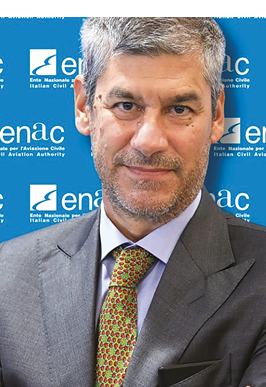“Volare oltre la vista, destinazione inclusione” promotes the inclusion of visually-impaired people in port handling jobs. The initiative, presented in Rome in May in the presence of Alessandra Locatelli, Minister for Disabilities, provides that three visually-impaired people will be trained and then work in ground assistance for passengers at Fiumicino Airport. We talk about this with Alessio Quaranta, General Manager of ENAC Civil Aviation Authority), one of the institutional partners.
How did this important initiative for inclusion come about?
It is based on a collaboration between the UICI (Unione Italiana Ciechi e Ipovedenti), and Swissport. For the first time in Italy, visually-impaired people will be employed in passenger assistance activities at an airport, and this should be just the first of many work inclusion opportunities for people with disabilities and reduced mobility.
It is a best practice to be copied in the near future in other means of transport, such as shipping and railways.
You fly toward the future from the airport. Is it a coincidence that this project started here?
The airport is a symbolic place, a metaphor for a sort of entrance to the world from which you leave, travel to take a connecting flight, and then arrive. It’s a global city where you meet countless people from different places, with different cultures and traditions, and this is why it’s important that a work inclusion project began here.
Therefore, we can have a work environment that enhances its employees’ potential?
Absolutely. For this to happen we first need a cultural change, and in this area Italy in general, and the air transportation industry in particular, have always been attentive and sensitive to inclusivity, accessibility, and assistance to passengers with disabilities and reduced mobility.
The second mandatory aspect is the one specified in the UN Convention with reference to “reasonable accommodations,” that is, “necessary and appropriate modification and adjustments not imposing a disproportionate or undue burden, where needed in a particular case, to ensure to persons with disabilities the enjoyment or exercise on an equal basis with others of all human rights and fundamental freedoms,” including an inclusive working environment.
Is our society ready to deal with situations involving people with visual impairment?
Without a doubt, there’s still a lot of work to do, especially with regard to culture and mindset. But I can say that we’re making progress, as confirmed by this initiative and by many others throughout the country, in many areas that have promoted and provided workplace inclusion for people with a variety of impairments. For example, ENAC recently sponsored a major event in Milan - “In & Aut Festival – Inclusione e Autismo”, dedicated to the social and job inclusion of autistic people in Italy, attended by several Italian organizations that have been committed to the job inclusion of autistic people for many years.

Are there other similar initiatives planned for the future?
Right now I can’t say, but I’m sure that this project is an important starting point and a good practice that will help increase public awareness of work inclusion for people with impairments.
ENAC will always back companies and organizations that promote this kind of initiative, supporting them and encouraging their projects so that the workplace inclusion of people with impairments will, in the near future, be not an exception, but normal.

.jpg)



.png)